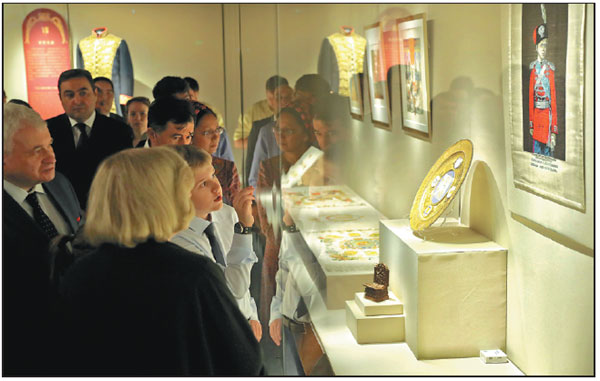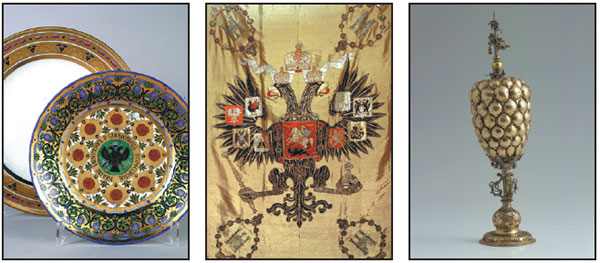Profusion of grandeur
From royal gowns to jewelry and dinnerware, the stunning exhibits at a new show in Beijing conjure up the splendor of Russian court ceremonies, Wang Kaihao reports.
When visitors step into the Shenwumen (Gate of Divine Prowess) Gallery at Beijing's Palace Museum, it feels almost as if they are attending a lavish coronation ceremony put on for a Russian czar from centuries ago.
More than 150 cultural relics from Moscow Kremlin Museums, the former imperial palace of the Romanov Dynasty (1613-1917), have been brought to Beijing for the ongoing exhibition Russian Court Ceremony, which runs through Nov 8.
|
From left: Exhibits at Russian Court Ceremony, an ongoing exhibition at the Palace Museum in Beijing - coronation garment of Maria Alexandrovna, empress of Alexander II; a portrait of Peter I; and a military uniform used for Alexander II's coronation. Photos by Jiang Dong / China Daily |
And perhaps, the Palace Museum - China's imperial palace from 1420 to 1911 which is also known as the Forbidden City - is the ideal place to host these precious exhibits, echoing their beauty through its own imperial grandeur.
Starting with a 1717 portrait of Peter the Great, another 200 years of history unfolds.
"He revolutionized court ceremonies in line with (Western) European traditions," Svetlana Amelekhina, the Russian curator of the exhibition, says.
She adds that these grand and solemn ceremonies followed established procedures that were invested with special political powers to help underline the legitimacy of Czarist rule.
From royal gowns and decorations to documentary archives, old photos and prints, the exhibits on display across eight sections cover the entire coronation procedure - from the opening announcements to the ceremony itself, through to the parades and extravagant banquets.
Almost every detail of the ceremonies is portrayed through the cultural relics.
The exquisite horse-riding gear, the formal attire worn by the riders, the grooms' silver swords and the ceremonial canopies help to conjure up the splendor of the scene.
Czarina Anna Ivanovna's crown, Catherine I's coronation gown, Alexander II's military uniform, and religious items used for coronations and a profusion of jewelry, including brooches, bracelets and necklaces, help to crate an even stronger impression.
One section of the exhibition was designed especially to depict royal banquets through a diverse set of dinnerware. When they cast an eye over a small salt dispenser made of gilded agate, visitors will find it easy to imagine the magnificence of the setting.
Most of the exhibits are "precious items that have been permitted to leave the Moscow Kremlin Museums", according to Amelekhina.
Although the Romanov dynasty moved its capital from Moscow to St. Petersburg in 1712, the most important ceremonies continued to be held at the Assumption Cathedral next to the Kremlin in Moscow.
"As a time-honored tradition, every Russian monarch since the 15th century has been crowned there," the curator says.
She adds that the exhibits are also a reflection of cultural communication between China and Russia.
"For example, the costumes may be woven in Russia or France, but they are made of silk from China," Amelekhina says.
The curator adds that many czars, especially the last monarch Nicolas II, were avid lovers of Chinese art, and a royal collection of Chinese artifacts was built up over the years.
"We might need another exhibition entirely to display them," she says.
Cooperation between China and Russia has been developing for well over a decade, as Lou Wei, deputy director of the Palace Museum, tells China Daily. Moscow Kremlin Museums first held an exhibition at the Beijing museum in 2006.
"However, the previous exhibition was a general selection of items from the Kremlin," Lou says. "As people's understanding of Russian culture improves, we need to narrow down the big topic to better introduce the history through a more specific theme."
This year marks the 70th anniversary of the establishment of diplomatic relations between China and Russia. In March, an exhibition put together by the Palace Museum opened at the Kremlin to display court rituals under the reign of Emperor Qianlong (1736-95), the peak of social prosperity during the Qing Dynasty (1644-1911).
"It was almost contemporaneous of what is being shown at the Russian counterpart of our museum," Lou says. "We would like to create cultural resonance by sharing similar topics."
He adds that future cultural cooperation will be expanded to fields beyond exhibitions.
The Palace Museum was inscribed as a UNESCO World Heritage site in 1987, while the Moscow Kremlin followed suit three years later in 1990.Lou says exchanges of experience managing world heritage sites and training of expertise in cultural relic conservation could be a new focus.
Contact the writer at wangkaihao@chinadaily.com.cn
|
Visitors look at cultural relics on loan from Moscow Kremlin Museums at the Palace Museum in Beijing. Jiang Dong / China Daily |
|
Dessert plates (left), a ceremonial canopy (center) and a goblet (right) are among typical exhibits that show court rituals of the Romanov dynasty. Photos Provided to China Daily |
(China Daily Global 09/03/2019 page14)





















